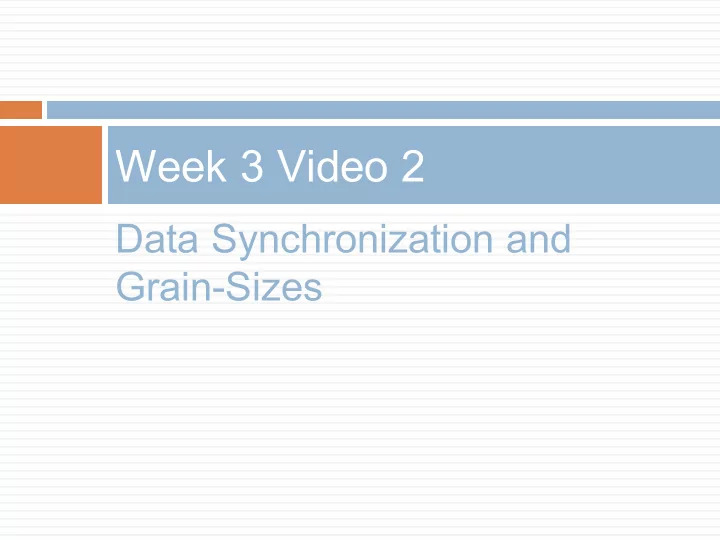

Week 3 Video 2 Data Synchronization and Grain-Sizes
You have ground truth training labels… ◻ How do you connect them to your log files? ◻ The problem of synchronization ◻ Turns out to be intertwined with the question of what grain-size to use
Grain-size ◻ What level do you want to detect the construct at?
Orienting Example ◻ Let’s say that you want to detect whether a student is gaming the system, and you have field observations of gaming ◻ Each observation has an entry time (e.g. when the coder noted the observation), but no start of observation time ◻ The problem is similar even if you have a time for the start of each observation
Data Monday 8am Gaming Monday 3pm Not Gaming Friday 3pm
Data Monday 8am Monday 3pm Notice the gap; maybe students were off this day… or maybe the observer couldn’t make it Friday 3pm
Orienting Example ◻ What grain-size do you want to detect gaming at? ◻ Student-level? ◻ Day-level? ◻ Lesson-level? ◻ Problem-level? ◻ Observation-level? ◻ Action-level?
Student level ◻ Average across all of your observations of the student, to get the percent of observations that were gaming
Student level Monday 8am Gaming 5 Gaming Monday 3pm 10 Not Gaming This student is 33.33% Gaming Not Gaming Friday 3pm
Student level Monday 8am 5 Gaming Monday 3pm 10 Not Gaming This student is 33.33% Gaming Friday 3pm
Notes ◻ Seen early in behavior detection work, when synchronization was difficult (cf. Baker et al., 2004) ◻ Makes sense sometimes � When you want to know how much students engage in a behavior � To drive overall reporting to teachers, administrators � To drive very coarse-level interventions ■ For example, if you want to select six students to receive additional tutoring over the next month
Day level ◻ Average across all of your observations of the student on a specific day, to get the percent of observations that were gaming
Day level Monday 8am Monday 40% Monday 3pm Tuesday 0% Wednesday 20% Thursday 0% Friday 40% Friday 3pm
Notes ◻ Affords finer intervention than student-level ◻ Still better for coarse-level interactions
Lesson level ◻ Average across all of your observations of the student within a specific level, to get the percent of observations that were gaming
Lesson level Monday 8am Lesson 1: 40% gaming Monday 3pm Lesson 2: 30% gaming Friday 3pm
Notes ◻ Can be used for end-of-lesson interventions ◻ Can be used for evaluating lesson quality
Problem level ◻ Average across all of your observations of the student within a specific problem, to get the percent of observations that were gaming
Problem level Monday 8am Monday 3pm Friday 3pm
Notes ◻ Can be used for end-of-problem or between- problem interventions � Fairly common type of intervention ◻ Can be used for evaluating problem quality
Challenge ◻ Sometimes observations cut across problems ◻ You can assign observation to � problem when observation entered � problem which had majority of observation time � both problems
Observation level ◻ Take each observation, and try to predict it
Observation level Monday 8am Gaming Monday 3pm Not Gaming Friday 3pm
Notes ◻ “Most natural” mapping ◻ Affords close-to-immediate intervention ◻ Also supports fine-grained discovery with models analyses
Challenge ◻ Synchronizing observations with log files ◻ Need to determine time window which observation occurred in � Usually only an end-time for field observations; you have to guess start-time � Even if you have start-time, exactly where in window did desired behavior occur? � How much do you trust your synchronization between observations and logs? ■ If you don’t trust it very much, you may want to use a wider window
Challenge ◻ How do you transform from action-level logs to time-window-level clips? � You can conduct careful feature engineering to create meaningful features out of all the actions in a clip � Or you can just hack counts, averages, stdev’s, min, max from the features of the actions in a clip (cf. Sao Pedro et al., 2012; Baker et al., 2012)
Action level ◻ You could also apply your observation labels to each action in the time window ◻ And then fit a model at the level of actions � Treating actions from the same clip as independent from one another ◻ Offers the potential for truly immediate intervention
Action level ◻ Some models identify the overall construct at the action level, but validate at the clip level (Paquette et al., 2015) ◻ Less certain, action by action, but allows more rapid and targeted intervention
Bottom-line ◻ There are several grain-sizes you can build models at ◻ Which grain-size you use determines � How much work you have to put in (coarser grain- sizes are less work to set up) � When you can use your models (more immediate use requires finer grain-sizes) ◻ It also influences how good your models are, although not in a perfectly deterministic way
Next Lecture ◻ Feature Engineering
Recommend
More recommend